Diferencia entre revisiones de «Mosasauridae»
m r2.6.4) (robot Añadido: ar:موزاصور |
Traducción en proceso de la Wikipedia inglesa |
||
| Línea 18: | Línea 18: | ||
Ver el texto. |
Ver el texto. |
||
}} |
}} |
||
| fossil_range = {{Fossil range|85|65|[[Late Cretaceous]]}} |
|||
| image = MosasaurMaastricht080910.JPG |
|||
| image_caption = ''Mosasaurus hoffmannii'' skeleton, Natural History Museum of Maastricht, The Netherlands |
|||
| taxon = Mosasauridae |
|||
| authority = [[Paul Gervais|Gervais]], 1853 |
|||
| subdivision_ranks = [[Subfamily|Subfamilies]] |
|||
| subdivision = |
|||
*†[[Halisaurinae]] |
|||
*†[[Mosasaurinae]] |
|||
*†[[Plioplatecarpinae]] |
|||
*†[[Tylosaurinae]] |
|||
}} |
|||
'''Mosasaurs''' (de ''Mosa'' forma latina del río '[[Meuse]]', y el [[Idioma griego antiguo|griego]] ''sauros'' que significa 'lagarto') son grandes lagartos marinos extintos. Los primeros restos fósiles fueron descubiertos en una cantera de caliza en [[Maastricht]] sobre las márgenes del Meuse en 1764. Los mosasaurios actualmente son considerados parientes cercanos de las [[serpiente]]s, debido a que los [[análisis cladísticos]] que se han realizado han hallado similitudes en la anatomía del cráneo y las mandíbulas.<ref>{{cite journal |author=Lee MSY |title=The phylogeny of varanoid lizards and the affinities of snakes |journal=Philos Trans R Soc Lond B Biol Sci. |volume=352 |issue=1349 |pages=53–91 |date=1997-01-29 |doi=10.1098/rstb.1997.0005 |pmc=1691912}}</ref> Los mosasaurios eran miembros de los [[Varanoidea|varanoide]]s, emparentados con los actuales lagartos [[varano]]s terrestres. Ellos probablemente evolucionaron de reptiles [[Squamata|escamosos]] semiacuáticos<ref>Los Squamata, u orden escamoso, consisten de los actuales varanoides, serpeintes y sus parienttes fósiles los mosasaurios.</ref> conocidos como los [[Aigialosauridae|aigialosáuridos]], los cuales son muy similares en apariencia alos modernos [[varano]]s, a fines del período [[Cretácico Inferior]]. Durante los últimos 20 millones de años del períod Cretácico ([[Turoniano]]-[[Maastrichtiano]]), con la desaparición de los [[ictiosaurio]]s y los [[pliosaurio]]s, los mosasaurios se volvieron los depredadores marinos dominantes. |
|||
==Descripción== |
|||
[[Archivo:MosasaurMaastricht080910.JPG|thumb|''Mosasaurus hoffmanni'']] |
|||
[[Image:Platecarpus2010.jpg|thumb|left|Recosntrucción moderna de ''[[Platecarpus tympaniticus ]]'' mostrando su aleta caudal de media luna]] |
|||
Los '''mosasáuridos''' ('''Mosasauridae'''[[extinción|†]]) son una [[familia (biología)|familia]] de [[saurópsido]]s (reptiles) [[escamosos]] que vivieron en el [[Cretácico superior]] en lo que hoy es [[América]], [[Europa]], [[África]], [[Oceanía]] y la [[Antártida]]. |
|||
[[Image:Tylosaurus.jpg|thumb|left|''Tylosaurus proriger'' erróneamente representado con una cresta dorsal, por [[Charles R. Knight]], [[1899]]. Esta imagen y similares estaban basadas en cartílagos traquelaes mal identificados, pero cuando el error fue descubierto, las representaciones de mosasaurios con dichas crestas depicting mosasaurs with such crests ya era una tendencia<ref>http://www.oceansofkansas.com/Osborn1899.html</ref><ref>http://www.oceansofkansas.com/Williston98.html</ref>]] |
|||
Los mosasaurios respiraban aire, eran poderosos nadadores, y estban bien adaptados a vivir en los mares epicontinentales cálidos y poco profundos, que predominaban a finales del período Cretácico. los mosasaurios se hallaban tan bien adaptados a su entorno que eran ya animales [[vivíparo]]s, en vez de retornar a las playas a depositar sus huevos, a la manera de las [[tortuga]]s marinas. |
|||
== Descripción == |
|||
El mosasaurio más pequeño conocido es ''[[Carinodens|Carinodens belgicus]]'', que medía entre 3.0 a 3.5 metros de largo y probablemente vivía en aguas someras cerca de las costas, rompiendo conchas de [[molusco]]s y [[erizos de mar]] consus dientes bulbosos y romos. Los mosasaurios grandes eran la norma: algunos alcanzaban hasta 17 metros de largo. ''[[Tylosaurus]]'' mantiene el título del mayor mosasaurio, con 17.5 m. |
|||
Los mosasáuridos están relacionados con los [[Varanidae|varanos]] (como el [[Varanus komodoensis|dragón de Komodo]]) y es el grupo relacionado mas estrechamente con las [[serpiente]]s.<ref>{{cita publicación |autor=Lee MSY |título=The phylogeny of varanoid lizards and the affinities of snakes |publicación=Philos Trans R Soc Lond B Biol Sci. |volumen=352 |número=1349 |páginas=53–91 |fecha=29-01-1997 |doi=10.1098/rstb.1997.0005 |pmc=1691912}}</ref> |
|||
Los mosasaurios tenían un perfil corporal similar al de sus parientes los largartos moniteres actuales (varánidos), pero eran m´´as alargados y aerodinámicos para nadar. Los huesos de sus miembros estaban muy reducidos en longitud y sus aletas estaban formadas por una membrana entre los alargados huesos de sus dígitos. Sus colas eran anchas, y proveían la fuerza de locomoción. Este método de locomoción pudo haber sido similar al que hoy en día usan los [[congrio]]s o las [[serpientes marinas]]. No obstante, evidencia más reciente sugiere que muchos mosasaurios avanzados tenían grandes aletas caudales en forma de luna creciente, similares a las de los [[tiburón|tiburones]] e [[ictiosaurio]]s. Más que desarrollar un movimiento ondulatorio serpentino, el cuerpo probablemente permanecía rígido en estos mosasaurios para mejorar la eficiencia hidrodinámica a través del agua mientras el final de la cola proporcionaba la propulsión.<ref name=LCKC10>{{cite journal |last=Lindgren |first=J. |coauthors=Caldwell, M.W.; Konishi, T.; and Chiappe, L.M. |year=2010 |editor1-last=Farke |editor1-first=Andrew Allen |title=Convergent evolution in aquatic tetrapods: Insights from an exceptional fossil mosasaur |journal=PLoS ONE |pmid=20711249 |volume=5 |issue=8 |pmc=2918493 |pages=e11998 |doi=10.1371/journal.pone.0011998}}</ref> El animal pudo haber acechado y luego abalanzarse rápidamente y con fuerza sobre la presa que pasaban, en lugar de tener que ir a cazarlas. |
|||
Los mosasáuridos son los mayores [[lagartos]] que han existido. Poseían largas mandíbulas y dientes robustos, una cola alta y extremidades en forma de paleta. Debían alimentarse de peces, aunque se han hallado [[ammonites]] [[fósil]]es con marcas de hileras dentales que encajan exactamente con el modelo de dentición de ciertos mosasáuridos. |
|||
Los mosasaurios tenían una doble bisagra en la mandíbula y un cráneo flexible (muy parecido al de una [[serpiente]]), con el cual eran capaces de engullir sus presas casi completas, un hábito de serpeinte que ha ayudado a identificar lso contenidos no masticados del estómago dentro de esqueletos de mosasaurios fosilizados. Así, un esqueleto de ''[[Tylosaurus]] proriger'' de [[Dakota del Sur]] inclñuía restos del ave buceadora ''[[Hesperornis]]'', algunos peces óseos, un posible [[tiburón]] y un mosasaurio pequeño, el ''Clidastes''. Los huesos de mosasaurio también han sido hallados con dientes de tiburón incrustados en ellos. |
|||
== Sistemática == |
|||
Basándose en características de sus doble fila de dientes pterigoidales en el paladar, la mandíbula con doble bisagra, lso miembros modificados y reducidos y sus porbables métodos de locomoción, muchos investigadores creen que las [[serpiente]]s y los mosasaurios pueden haber tenido un ancestro común. Esta teoría fue sugerida originalmente en 1869, por [[Edward Drinker Cope]], quien acuñó el término "Pythonomorpha" para incluirlos. La idea permaneció latente por más de un siglo, antes de ser revivida en la década de 1990.<ref name=palaeos>[http://www.palaeos.com/Vertebrates/Units/Unit260/260.100.html Palaeos Vertebrates 260.100 Pythonomorpha: Pythonomorpha]</ref><ref>[http://www.oceansofkansas.com/Greatrep.html Mosasaurs: Last of the Great Marine Reptiles]</ref> |
|||
* '''Familia''' '''Mosasauridae'''[[extinción|†]] |
|||
*** ''[[Vallecillosaurus]]'' |
|||
===Tejidos blandos=== |
|||
** '''Subfamilia''' '''Tylosaurinae''' |
|||
[[Image:Tylosaurus skin.jpg|thumb|left|Escamas de ''Tylosaurus proriger'' (KUVP-1075)]] |
|||
*** ''[[Hainosaurus]]'' |
|||
A pesar del relativamente gran número de restos de mosaaurio recolectados mundialmente, el conocimiento de la naturaleza de su cubierta de piel permaneció en sus primeros estadios. Una increíblemente pequeña cantidad de especímenes de mosasaurio conocidos de varias locaciones del mundo retenían impresiones fosilizadas de sus escamas; esta carencia de conocimiento fue posible por la naturaleza delicada de las escamas, que casi elimina las posibilidades de preservción, además de que no se conocían los tipos de sedimentos de preservación y las condiciones marinas bajo las cuales dicha preservación ocurre. Until the discovery of several mosasaur specimens along with their remarkably well preserved scale imprints from late [[Maastricht]]ian deposits of the [[Muwaqqar Chalk Marl Formation]] of [[Harrana]]<ref name=Kaddumi>{{cite book |last=Kaddumi |first=H.F. |year=2009 |chapter=On the latest scale coverings of mosasaurs (Squamata: ''Mosasauridae'') from the Harrana Fauna in addition to the description of s new species of Mosasaurus |title=Fossils of the Harrana Fauna and the Adjacent Areas |publisher=Eternal River Museum of Natural History |location=[[Amman]] |pages=80–94}}</ref> in [[Jordan]], knowledge of the nature of mosasaur integument was mainly based on very few accounts describing early mosasaur fossils dating back to the upper [[Santonian]]-lower [[Campanian]] such as the famous [[Tylosaurus]] specimen (KUVP-1075) from [[Cove County, Kansas]].<ref name=Snow>{{cite journal |last=Snow |first=F. H. |year=1878 |title=On the dermal covering of a mosasauroid reptile |journal=Transactions of the Kansas Academy of Science |volume=6 |pages=54–58}}</ref> Material from Jordan has shown that the body of mosasaurs, as well as the membrane between the fingers and toes, was covered with small overlapping diamond-shaped scales resembling those of snakes. Much like modern reptiles, there existed regional variations in the type and size of the scales that covered the mosasaurs. In Harrana specimens, two types of scales were observed on a single specimen,<ref name=Kaddumi/> keeled scales covering the upper regions of the body as well as smooth scales covering the lower regions. As ambush predators, lurking and quickly capturing prey using stealth tactics,<ref name=Massare>{{cite journal |doi=10.1080/02724634.1987.10011647 |last=Massare |first=J. A. |year=1987 |title=Tooth morphology and prey preference of Mesozoic marine reptiles |journal=Journal of Vertebrate Paleontology |volume=7 |issue=2 |pages=121–137}}</ref> it is suggested mosasaurs benefited greatly from the non-reflective keeled scales.<ref name=Kaddumi/> |
|||
*** ''[[Tylosaurus]]'' |
|||
[[Image:Soft tissue structures in Platecarpus.png|thumb|Soft tissues in the head and neck of ''Platecarpus tympaniticus'' specimen LACM 128319. Tracheal rings are shown in the bottom three photographs.]] |
|||
*** ''[[Taniwhasaurus]]''? |
|||
More recently, a well preserved fossil of ''[[Platecarpus|Platecarpus tympaniticus]]'' has been found that preserves not only skin impressions, but also internal organs. There are several reddish areas in the fossil that may represent the heart, lungs, and kidneys. The trachea is also preserved along with part of what may be the [[retina]] in the eye. The placement of the kidneys is farther forward in the abdomen than it is in monitor lizards, and is more similar to that of [[cetacean]]s. As in cetaceans, the [[bronchi]] leading to the lungs run parallel to each other instead of splitting apart from one another as in monitors and other terrestrial reptiles. In mosasaurs, these features may be internal adaptations to a fully marine lifestyle.<ref name=LCKC10/> |
|||
*** ''[[Lakumasaurus]]'' |
|||
[[File:Prognathodon tissue.jpg|thumb|left|Fibrous tissues and microstructures recovered from IRSNB 1624]] |
|||
** '''Subfamilia''' '''Plioplatecarpinae''' |
|||
In 2011, [[collagen]] protein was recovered from a ''[[Prognathodon]]'' humerus dated to the [[Cretaceous]].<ref>http://www.plosone.org/article/info%3Adoi%2F10.1371%2Fjournal.pone.0019445</ref> |
|||
*** ''[[Platecarpus]]'' |
|||
==Environment== |
|||
*** ''[[Ectenosaurus]]'' |
|||
Sea levels were high during the Cretaceous Period, causing marine transgressions in many parts of the world and a [[Western Interior Seaway|great inland seaway]] in what is now North America. Mosasaur [[fossil]]s have been found in the [[Netherlands]], [[Denmark]], [[Portugal]], [[Sweden]], the [[United Kingdom]],<ref>www.english-nature.org.uk/citation/citation_photo/2000158.pdf</ref> [[Angola]], [[Morocco]], [[Australia]], [[New Zealand]], and on [[Vega Island]] off the coast of Antarctica. Mosasaurs have been found in [[Canada]] in [[Manitoba]] and [[Saskatchewan]]<ref>http://www.discoverfossils.com</ref> and in much of the contiguous United States. Complete or partial specimens have been found in [[Alabama]], [[Mississippi]], [[Tennessee]], and [[Georgia (U.S. state)|Georgia]] -- as well as in states covered by the Cretaceous seaway: [[Texas]], southwest [[Arkansas]], [[New Mexico]], [[Kansas]],<ref>{{cite book |author=Michael J. Everhart |title=Oceans of Kansas: a natural history of the western interior sea |publisher=Indiana University Press |location=Bloomington |year=2005 |isbn=0-253-34547-2 |chapter=Chapter 9: Enter the Mosasaurs}}</ref> [[Colorado]], [[Nebraska]], [[South Dakota]], [[Montana]], and the [[Pierre Shale]]/[[Fox Hills]] formations of [[North Dakota]].<ref>{{cite paper |author=Getman, Myron RC |title =Occurrences of Mosasaur and other reptilian fossil remains from the Fox Hills Formation (Maastrichtian: late Cretaceous) of North Dakota |publisher=St. Lawrence University Dept. of Geology theses |year=1994 }}</ref> Lastly, mosasaur bones and teeth are also known from [[California]], [[Mexico]], and [[Peru]]. |
|||
*** ''[[Selmasaurus]]'' |
|||
*** ''[[Igdamanosaurus]]'' |
|||
Many of the so-called 'dinosaur' remains found on [[New Zealand]] are actually mosasaurs and [[plesiosaur]]s, both being Mesozoic predatory marine reptiles. |
|||
*** ''[[Yaguarasaurus]]'' |
|||
*** ''[[Plioplatecarpus]]'' |
|||
==Discovery== |
|||
** '''Subfamilia''' '''Mosasaurinae''' |
|||
[[Image:Mosasaurus.jpg|thumb|The ''Mosasaurus hoffmannii'' skull found in Maastricht between 1770 and 1774]] |
|||
*** ''[[Clidastes]]'' |
|||
The first publicized discovery of a partial fossil mosasaur skull in 1764 by quarry-workers in a subterranean gallery of a limestone quarry near the Dutch city of [[Maastricht]], preceded any major dinosaur fossil discoveries but remained little known. However, a second find of a partial skull drew the [[Age of Enlightenment]]'s attention to the existence of fossilized animals that were different from any known living creatures. When the specimen was discovered between 1770 and 1774, [[Johann Leonard Hoffmann]], a surgeon and fossil-collector, corresponded about it with the most influential scientists of his day, making the fossil famous. The original owner though was Godding, a canon of Maastricht cathedral. |
|||
*** ''[[Mosasaurus]]'' |
|||
*** ''[[Moanasaurus]]'' |
|||
When the French [[Wars of the French Revolution|Revolutionary forces]] occupied Maastricht in 1794, the carefully hidden fossil was uncovered, after a reward, it is said, of six hundred bottles of wine, and transported to Paris. After it had been earlier interpreted as a fish, a crocodile and a sperm whale, the first to understand its lizard affinities was the Dutch scientist [[Adriaan Gilles Camper]] in 1799. In 1808 [[Georges Cuvier]] confirmed this conclusion, although ''le Grand Animal fossile de Maëstricht'' was not actually named ''Mosasaurus'' ('[[Meuse River|Meuse]] reptile') until 1822 and not given its full species name, ''Mosasaurus hoffmannii,'' until 1829. Several sets of mosasaur remains, that had been discovered earlier at Maastricht but were not identified as mosasaurs until the nineteenth century, have been on display in the [[Teylers Museum]], [[Haarlem]], procured from 1790. |
|||
*** ''[[Amphekepubis]]'' |
|||
*** ''[[Liodon]]''? |
|||
The Maastricht [[limestone]] beds were rendered so famous by the Mosasaur discovery that they have given their name to the final six-million-year epoch of the Cretaceous, the [[Maastrichtian]]. |
|||
*** ''[[Plotosaurus]]'' |
|||
*** ''[[Globidens]]'' |
|||
== Taxonomy == |
|||
*** ''[[Prognathodon]]'' |
|||
{{See also|List of mosasaurs}} |
|||
*** ''[[Plesiotylosaurus]]'' |
|||
===Classification=== |
|||
*** ''[[Carinodens]]''? |
|||
[[Image:Mosasaurs.jpg|thumb|Drawing from Williston (1898) that shows the skeletons of three common species of mosasaurs from Kansas; ''Clidastes propython'', ''Platecarpus tympaniticus'' and ''Tylosaurus proriger'']] |
|||
*** ''[[Goronyosaurus]]''? |
|||
[[Image:Taniwhasaurus.jpg|thumb|right|150px|''[[Taniwhasaurus]]''.]] |
|||
*** ''[[Pluridens]]''? |
|||
[[Image:Clidastes proph1DB.jpg|thumb|right|150px|''[[Clidastes]]''.]] |
|||
** '''Subfamilia''' '''Halisaurinae ''' |
|||
[[Image:Prognathodon3.jpg|thumb|right|150px|''[[Prognathodon]]''.]] |
|||
*** ''[[Eonatator]]'' |
|||
*'''Family ''' '''Mosasauridae''' |
|||
*** ''[[Halisaurus]]'' |
|||
**'''Subfamily ''' '''Tylosaurinae''' |
|||
***''[[Hainosaurus]]'' |
|||
***''[[Tylosaurus]]'' |
|||
***''[[Taniwhasaurus]]'' |
|||
**'''Subfamily ''' '''Plioplatecarpinae''' |
|||
***''[[Platecarpus]]'' |
|||
***''[[Angolasaurus]]'' |
|||
***''[[Ectenosaurus]]'' |
|||
***''[[Selmasaurus]]'' |
|||
***''[[Igdamanosaurus]]'' |
|||
***''[[Yaguarasaurus]]'' |
|||
***''[[Plioplatecarpus]]'' |
|||
**'''Subfamily ''' '''Mosasaurinae''' |
|||
***''[[Dallasaurus]]'' |
|||
***''[[Clidastes]]'' |
|||
***''[[Mosasaurus]]'' |
|||
***''[[Moanasaurus]]'' |
|||
***''[[Amphekepubis]]'' |
|||
***''[[Plotosaurus]]'' |
|||
***''[[Globidens]]'' |
|||
***''[[Prognathodon]]'' |
|||
***''[[Plesiotylosaurus]]'' |
|||
***''[[Carinodens]]'' |
|||
**'''Subfamily ''' '''Halisaurinae ''' |
|||
***''[[Eonatator]]'' |
|||
***''[[Halisaurus]]'' |
|||
'''Incertae sedis''' |
'''Incertae sedis''' |
||
* |
*''[[Liodon]]'' |
||
* |
*''[[Goronyosaurus]]'' |
||
* |
*''[[Pluridens]]'' |
||
* |
*''[[Kourisodon]]'' |
||
* |
*''[[Russellosaurus]]'' |
||
* |
*''[[Tethysaurus]]'' |
||
* ''[[Russellosaurus]]'' |
|||
===Phylogeny=== |
|||
* ''[[Tethysaurus]]'' |
|||
[[Cladogram]] of mosasaurs and related taxa modified from Bell and Polcyn, 2005:<ref name=BP05>{{cite journal |last=Bell |first=G. L. Jr. |coauthor=and Polcyn, M. J. |title=''Dallasaurus turneri'', a new primitive mosasauroid from the Middle Turonian of Texas and comments on the phylogeny of Mosasauridae (Squamata) |journal=Netherlands Journal of Geosciences — Geologie en Mijnbouw |volume=84 |issue=3 |pages=177–194}}</ref> |
|||
{{clade| style=font-size:85%;line-height:85% |
|||
|label1=[[Mosasauroidea]] |
|||
|1={{clade |
|||
|label1= [[Aigialosauridae]] |
|||
|1={{clade |
|||
|1=[[Aigialosaurus|Aigialosaurus dalmaticus]]}} |
|||
|label2= '''Mosasauridae''' |
|||
|2={{clade |
|||
|label1= [[Mosasaurinae]] |
|||
|1={{clade |
|||
|1=[[Dallasaurus|Dallasaurus turneri]] |
|||
|2={{clade |
|||
|1={{clade |
|||
|1=[[Clidastes|''Clidastes'' KU-''liodontus'']] |
|||
|2=[[Clidastes|''Clidastes'' YP-''liodontus'']]}} |
|||
|2={{clade |
|||
|1=''[[Clidastes|Clidastes moorevillensis]]'' |
|||
|2={{clade |
|||
|1=[[Clidastes|''Clidastes'' novum sp.]] |
|||
|2={{clade |
|||
|1=''[[Clidastes|Clidastes propython]]'' |
|||
|2={{clade |
|||
|1={{clade |
|||
|1={{clade |
|||
|1=''[[Globidens|Globidens alabamaensis]]'' |
|||
|2=''[[Globidens|Globidens dakotensis]]''}} |
|||
|2={{clade |
|||
|1=''[[Prognathodon|Prognathodon overtoni]]'' |
|||
|2={{clade |
|||
|1=''[[Plesiotylosaurus|Plesiotylosaurus crassidens]]'' |
|||
|2=''[[Prognathodon|Prognathodon rapax]]''}} }} }} |
|||
|2={{clade |
|||
|1=''[[Mosasaurus|Mosasaurus conodon]]'' |
|||
|2={{clade |
|||
|1=''[[Mosasaurus|Mosasaurus missouriensis]]'' |
|||
|2={{clade |
|||
|1={{clade |
|||
|1=''[[Mosasaurus]]'' indet. |
|||
|2=''[[Mosasaurus|Mosasaurus maximus]]''}} |
|||
|2={{clade |
|||
|1=''[[Plotosaurus|Plotosaurus bensoni]]'' |
|||
|2=''[[Plotosaurus|Plotosaurus tuckeri]]''}} }} }} }} }} }} }} }} }} }} |
|||
|2={{clade |
|||
|1=''[[Haasiasaurus|Haasiasaurus gittelmani]]'' |
|||
|2={{clade |
|||
|label1= [[Halisauromorpha]] |
|||
|1={{clade |
|||
|1=Trieste aigialosaur |
|||
|2={{clade |
|||
|1={{clade |
|||
|1=''[[Halisaurus]]'' novum sp. |
|||
|2=''[[Halisaurus|Halisaurus platyspondylus]]''}} |
|||
|2={{clade |
|||
|1=''[[Halisaurus|Halisaurus sternbergi]]'' |
|||
|2=[[Halisaurus|''Halosaurus'' cf. ''sternbergi'']]}} }} }} |
|||
|label2= [[Russellosaurina]] |
|||
|2={{clade |
|||
|1={{clade |
|||
|1={{clade |
|||
|1={{clade |
|||
|1=''[[Ectenosaurus|Ectenosaurus clidastoides]]'' |
|||
|2=''[[Ectenosaurus]]'' YPcomposit}} |
|||
|2={{clade |
|||
|1=''[[Platecarpus|Platecarpus planifrons]]'' |
|||
|2={{clade |
|||
|1=''[[Angolasaurus|Angolasaurus bocagei]]'' |
|||
|2={{clade |
|||
|1=''[[Platecarpus|Platecarpus 600tympaniticus]]'' |
|||
|2={{clade |
|||
|1=''[[Platecarpus|Platecarpus 8769tympaniticus]]'' |
|||
|2={{clade |
|||
|1=''[[Plioplatecarpus]]'' AMNH sp. |
|||
|2=''[[Plioplatecarpus]]'' RMM sp.}} }} }} }} }} }} |
|||
|2={{clade |
|||
|1=''[[Tylosaurus]]'' novum sp. |
|||
|2={{clade |
|||
|1=''[[Tylosaurus|Tylosaurus nepaeolicus]]'' |
|||
|2=''[[Tylosaurus|Tylosaurus proriger]]''}} }} }} |
|||
|2={{clade |
|||
|1=''[[Tethysaurus|Tethysaurus nopcsai]]'' |
|||
|2={{clade |
|||
|1=''[[Yaguarasaurus|Yaguarasaurus columbianus]]'' |
|||
|2=''[[Russellosaurus|Russellosaurus coheni]]'' |
|||
}} }} }} }} }} }} }} }} |
|||
==Evolutionary antecedents== |
|||
[[Image:Aigialosaurus bucchichi.jpg|thumb|Restoration of ''Aigialosaurus bucchichi'', a basal mosasaur]] |
|||
Based on features such as the loosely-hinged jaw, modified/reduced limbs and probable locomotion, many researchers believe that [[snakes]] share a common marine ancestry with mosasaurs, a suggestion advanced in 1869, by [[Edward Drinker Cope]], who coined the term "Pythonomorpha" to unite them. The idea lay dormant for more than a century, to be revived in the 1990s.<ref name="palaeos"/> Recently, the discovery of ''[[Najash rionegrina]]'', a fossorial snake from South America cast doubt on the marine origin theory. |
|||
On 2005-11-16, research reported in ''Netherlands Journal of Geosciences'', confirmed that the recently uncovered ''[[Dallasaurus|Dallasaurus turneri]]'' is an early link between land-based [[monitor lizard]]s (such as the [[Komodo dragon]]) and the aquatic mosasaurs.<ref>[http://www.smu.edu/smunews/dallasaurus/ Dallasaurus / Ancient Mosasaur - Dallasaurus - SMU<!-- Bot generated title -->]</ref> |
|||
==Distribution== |
|||
The following is a list of geologic formations that have produced mosasaur fossils. |
|||
{{Expand list|date=February 2010}} |
|||
{| class="wikitable sortable" align="center" width="100%" |
|||
|- |
|||
! Name |
|||
! Age |
|||
! Location |
|||
! Notes |
|||
|- |
|||
| |
|||
[[Moreno Formation]] |
|||
| |
|||
| |
|||
* {{Flag|USA}} |
|||
| |
|||
|- |
|||
| |
|||
[[Niobrara Formation]] |
|||
| |
|||
| |
|||
* {{Flag|USA}} |
|||
| |
|||
|- |
|||
|} |
|||
==In popular culture== |
|||
*Mosasaurs appear in the BBC television series ''[[Sea Monsters – A Walking with Dinosaurs Trilogy|Sea Monsters]]''. |
|||
*Mosasaurs also feature heavily in the ITV television series ''[[Primeval (TV series)|Primeval]]''. In this show, the mosasaurs are depicted incorrectly {{Citation needed|date=May 2009}} as having skin more like a [[crocodile]]'s. |
|||
*A highly evolved mosasaur appeared in an episode of ''[[Godzilla: The Series]]''. It was inhabiting [[Loch Ness]] as the legendary [[Loch Ness Monster]]. |
|||
*The IMAX 3D film "Sea Monsters" features several mosasaurs (including ''Tylosaurus'' and ''[[Platecarpus]]'') with detailed animated recreations of their movements and activities. |
|||
*In Disney's [[Fantasia]], there is a scene where a pod of mosasaurs are swimming by and one of them grabs a [[pteranodon]]. |
|||
==References== |
|||
{{reflist|2}} |
|||
==External links== |
|||
{{Commons category|Mosasauridae}} |
|||
* [http://www.palaeos.com/Vertebrates/Units/Unit260/260.100.html Palaeos: Vertebrates: Mosasaurs] |
|||
* [http://www.bbc.co.uk/science/seamonsters/factfiles/giantmosasaur.shtml BBC Science and Nature: Mosasaurs] |
|||
* [http://www.oceansofkansas.com/nz-aus.html Mike Everhart and David Lewis, "Mesozoic marine monsters of the Mangahouanga"]: New Zealand fossil fauna |
|||
* [http://www.oceansofkansas.com/mosa-sty.html Mike Everhart, "A day in the life of a Mosasaur"]: life in the Sea of Kansas, illus. by Carl Buell |
|||
* [http://www.oceansofkansas.com/mosahoff.html Mike Everhart, "''Mosasaurus hoffmani''"] until 1829. |
|||
* [http://www.tmm.utexas.edu/exhibits/mosasaur/ ''Mosasaurus maximus'' mounted skeleton at University of Texas Memorial Museum] |
|||
* [http://www.discoverfossils.com Canadian Fossil Discovery Centre] |
|||
* [http://crossroads.journalismcentre.com/2007/the-mosasaur-of-maastricht/ "The Mosasaur of Maastricht"] by Hennie Reuvers in [http://crossroads.journalismcentre.com/ Crossroads web magazine] |
|||
* [http://planetearth.nerc.ac.uk/news/story.aspx?id=492 "Mosasaurs terrorized Cretaceous rivers" Planet Earth online] |
|||
* [http://www.georgiasouthern.edu/museum Georgia Southern University Museum Mosasaur Exhibit] |
|||
{{Mosasauridae}} |
|||
{{Varanoidea}} |
|||
[[Category:Mosasaurs]] |
|||
[[Category:Cretaceous lizards]] |
|||
[[Category:Lizards|M]] |
|||
[[ar:موزاصور]] |
|||
== Referencias == |
|||
[[bg:Мозазаври]] |
|||
{{listaref}} |
|||
[[cs:Mosasauridae]] |
|||
[[de:Mosasaurier]] |
|||
[[es:Mosasauridae]] |
|||
[[fr:Mosasauridae]] |
|||
[[hr:Mozasauri]] |
|||
[[it:Mosasauridae]] |
|||
[[ka:მოზაზავრები]] |
|||
[[hu:Moszaszauruszok]] |
|||
[[nl:Mosasauridae]] |
|||
[[pl:Mozazaury]] |
|||
[[pt:Mosassauro]] |
|||
[[ro:Mozazaur]] |
|||
[[ru:Мозазавры]] |
|||
[[sk:Mosasauridae]] |
|||
[[sv:Mosasaurier]] |
|||
[[th:โมซาซอร์]] |
|||
[[zh:滄龍科]] |
|||
== Enlaces externos == |
|||
{{wikispecies}} |
|||
[[Categoría:Fósiles]] |
[[Categoría:Fósiles]] |
||
Revisión del 02:23 10 jun 2011
| Mosasauridae | ||
|---|---|---|
| Rango temporal: Cretácico superior | ||
 | ||
| Estado de conservación | ||
| Extinto (fósil) | ||
| Taxonomía | ||
| Reino: | Animalia | |
| Filo: | Chordata | |
| Clase: | Sauropsida | |
| Subclase: | Diapsida | |
| Orden: | Squamata | |
| Suborden: | Lacertilia | |
| Familia: |
Mosasauridae† Gervais, 1853 | |
| Géneros | ||
Ver el texto. | ||
| fossil_range = Late Cretaceous
| image = MosasaurMaastricht080910.JPG | image_caption = Mosasaurus hoffmannii skeleton, Natural History Museum of Maastricht, The Netherlands | taxon = Mosasauridae | authority = Gervais, 1853 | subdivision_ranks = Subfamilies | subdivision =
}} Mosasaurs (de Mosa forma latina del río 'Meuse', y el griego sauros que significa 'lagarto') son grandes lagartos marinos extintos. Los primeros restos fósiles fueron descubiertos en una cantera de caliza en Maastricht sobre las márgenes del Meuse en 1764. Los mosasaurios actualmente son considerados parientes cercanos de las serpientes, debido a que los análisis cladísticos que se han realizado han hallado similitudes en la anatomía del cráneo y las mandíbulas.[1] Los mosasaurios eran miembros de los varanoides, emparentados con los actuales lagartos varanos terrestres. Ellos probablemente evolucionaron de reptiles escamosos semiacuáticos[2] conocidos como los aigialosáuridos, los cuales son muy similares en apariencia alos modernos varanos, a fines del período Cretácico Inferior. Durante los últimos 20 millones de años del períod Cretácico (Turoniano-Maastrichtiano), con la desaparición de los ictiosaurios y los pliosaurios, los mosasaurios se volvieron los depredadores marinos dominantes.
Descripción


Los mosasaurios respiraban aire, eran poderosos nadadores, y estban bien adaptados a vivir en los mares epicontinentales cálidos y poco profundos, que predominaban a finales del período Cretácico. los mosasaurios se hallaban tan bien adaptados a su entorno que eran ya animales vivíparos, en vez de retornar a las playas a depositar sus huevos, a la manera de las tortugas marinas.
El mosasaurio más pequeño conocido es Carinodens belgicus, que medía entre 3.0 a 3.5 metros de largo y probablemente vivía en aguas someras cerca de las costas, rompiendo conchas de moluscos y erizos de mar consus dientes bulbosos y romos. Los mosasaurios grandes eran la norma: algunos alcanzaban hasta 17 metros de largo. Tylosaurus mantiene el título del mayor mosasaurio, con 17.5 m.
Los mosasaurios tenían un perfil corporal similar al de sus parientes los largartos moniteres actuales (varánidos), pero eran m´´as alargados y aerodinámicos para nadar. Los huesos de sus miembros estaban muy reducidos en longitud y sus aletas estaban formadas por una membrana entre los alargados huesos de sus dígitos. Sus colas eran anchas, y proveían la fuerza de locomoción. Este método de locomoción pudo haber sido similar al que hoy en día usan los congrios o las serpientes marinas. No obstante, evidencia más reciente sugiere que muchos mosasaurios avanzados tenían grandes aletas caudales en forma de luna creciente, similares a las de los tiburones e ictiosaurios. Más que desarrollar un movimiento ondulatorio serpentino, el cuerpo probablemente permanecía rígido en estos mosasaurios para mejorar la eficiencia hidrodinámica a través del agua mientras el final de la cola proporcionaba la propulsión.[5] El animal pudo haber acechado y luego abalanzarse rápidamente y con fuerza sobre la presa que pasaban, en lugar de tener que ir a cazarlas.
Los mosasaurios tenían una doble bisagra en la mandíbula y un cráneo flexible (muy parecido al de una serpiente), con el cual eran capaces de engullir sus presas casi completas, un hábito de serpeinte que ha ayudado a identificar lso contenidos no masticados del estómago dentro de esqueletos de mosasaurios fosilizados. Así, un esqueleto de Tylosaurus proriger de Dakota del Sur inclñuía restos del ave buceadora Hesperornis, algunos peces óseos, un posible tiburón y un mosasaurio pequeño, el Clidastes. Los huesos de mosasaurio también han sido hallados con dientes de tiburón incrustados en ellos.
Basándose en características de sus doble fila de dientes pterigoidales en el paladar, la mandíbula con doble bisagra, lso miembros modificados y reducidos y sus porbables métodos de locomoción, muchos investigadores creen que las serpientes y los mosasaurios pueden haber tenido un ancestro común. Esta teoría fue sugerida originalmente en 1869, por Edward Drinker Cope, quien acuñó el término "Pythonomorpha" para incluirlos. La idea permaneció latente por más de un siglo, antes de ser revivida en la década de 1990.[6][7]
Tejidos blandos
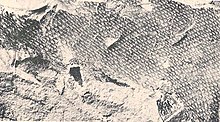
A pesar del relativamente gran número de restos de mosaaurio recolectados mundialmente, el conocimiento de la naturaleza de su cubierta de piel permaneció en sus primeros estadios. Una increíblemente pequeña cantidad de especímenes de mosasaurio conocidos de varias locaciones del mundo retenían impresiones fosilizadas de sus escamas; esta carencia de conocimiento fue posible por la naturaleza delicada de las escamas, que casi elimina las posibilidades de preservción, además de que no se conocían los tipos de sedimentos de preservación y las condiciones marinas bajo las cuales dicha preservación ocurre. Until the discovery of several mosasaur specimens along with their remarkably well preserved scale imprints from late Maastrichtian deposits of the Muwaqqar Chalk Marl Formation of Harrana[8] in Jordan, knowledge of the nature of mosasaur integument was mainly based on very few accounts describing early mosasaur fossils dating back to the upper Santonian-lower Campanian such as the famous Tylosaurus specimen (KUVP-1075) from Cove County, Kansas.[9] Material from Jordan has shown that the body of mosasaurs, as well as the membrane between the fingers and toes, was covered with small overlapping diamond-shaped scales resembling those of snakes. Much like modern reptiles, there existed regional variations in the type and size of the scales that covered the mosasaurs. In Harrana specimens, two types of scales were observed on a single specimen,[8] keeled scales covering the upper regions of the body as well as smooth scales covering the lower regions. As ambush predators, lurking and quickly capturing prey using stealth tactics,[10] it is suggested mosasaurs benefited greatly from the non-reflective keeled scales.[8]
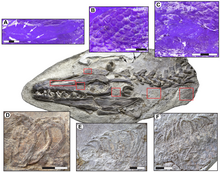
More recently, a well preserved fossil of Platecarpus tympaniticus has been found that preserves not only skin impressions, but also internal organs. There are several reddish areas in the fossil that may represent the heart, lungs, and kidneys. The trachea is also preserved along with part of what may be the retina in the eye. The placement of the kidneys is farther forward in the abdomen than it is in monitor lizards, and is more similar to that of cetaceans. As in cetaceans, the bronchi leading to the lungs run parallel to each other instead of splitting apart from one another as in monitors and other terrestrial reptiles. In mosasaurs, these features may be internal adaptations to a fully marine lifestyle.[5]
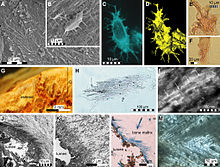
In 2011, collagen protein was recovered from a Prognathodon humerus dated to the Cretaceous.[11]
Environment
Sea levels were high during the Cretaceous Period, causing marine transgressions in many parts of the world and a great inland seaway in what is now North America. Mosasaur fossils have been found in the Netherlands, Denmark, Portugal, Sweden, the United Kingdom,[12] Angola, Morocco, Australia, New Zealand, and on Vega Island off the coast of Antarctica. Mosasaurs have been found in Canada in Manitoba and Saskatchewan[13] and in much of the contiguous United States. Complete or partial specimens have been found in Alabama, Mississippi, Tennessee, and Georgia -- as well as in states covered by the Cretaceous seaway: Texas, southwest Arkansas, New Mexico, Kansas,[14] Colorado, Nebraska, South Dakota, Montana, and the Pierre Shale/Fox Hills formations of North Dakota.[15] Lastly, mosasaur bones and teeth are also known from California, Mexico, and Peru.
Many of the so-called 'dinosaur' remains found on New Zealand are actually mosasaurs and plesiosaurs, both being Mesozoic predatory marine reptiles.
Discovery
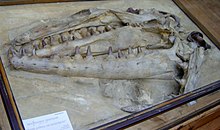
The first publicized discovery of a partial fossil mosasaur skull in 1764 by quarry-workers in a subterranean gallery of a limestone quarry near the Dutch city of Maastricht, preceded any major dinosaur fossil discoveries but remained little known. However, a second find of a partial skull drew the Age of Enlightenment's attention to the existence of fossilized animals that were different from any known living creatures. When the specimen was discovered between 1770 and 1774, Johann Leonard Hoffmann, a surgeon and fossil-collector, corresponded about it with the most influential scientists of his day, making the fossil famous. The original owner though was Godding, a canon of Maastricht cathedral.
When the French Revolutionary forces occupied Maastricht in 1794, the carefully hidden fossil was uncovered, after a reward, it is said, of six hundred bottles of wine, and transported to Paris. After it had been earlier interpreted as a fish, a crocodile and a sperm whale, the first to understand its lizard affinities was the Dutch scientist Adriaan Gilles Camper in 1799. In 1808 Georges Cuvier confirmed this conclusion, although le Grand Animal fossile de Maëstricht was not actually named Mosasaurus ('Meuse reptile') until 1822 and not given its full species name, Mosasaurus hoffmannii, until 1829. Several sets of mosasaur remains, that had been discovered earlier at Maastricht but were not identified as mosasaurs until the nineteenth century, have been on display in the Teylers Museum, Haarlem, procured from 1790.
The Maastricht limestone beds were rendered so famous by the Mosasaur discovery that they have given their name to the final six-million-year epoch of the Cretaceous, the Maastrichtian.
Taxonomy
Classification
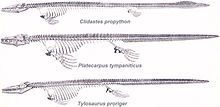

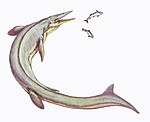

- Family Mosasauridae
- Subfamily Tylosaurinae
- Subfamily Plioplatecarpinae
- Subfamily Mosasaurinae
- Subfamily Halisaurinae
Incertae sedis
Phylogeny
Cladogram of mosasaurs and related taxa modified from Bell and Polcyn, 2005:[16]
| Mosasauroidea |
| |||||||||||||||||||||||||||||||||||||||||||||||||||||||||||||||||||||||||||||||||||||||||||||||||||||||||||||||||||||||||||||||||||||||||||||||||||||||||||||||||||||||||||||||||||||||||||||||||||||||||||||||||||||||||||||||||
Evolutionary antecedents

Based on features such as the loosely-hinged jaw, modified/reduced limbs and probable locomotion, many researchers believe that snakes share a common marine ancestry with mosasaurs, a suggestion advanced in 1869, by Edward Drinker Cope, who coined the term "Pythonomorpha" to unite them. The idea lay dormant for more than a century, to be revived in the 1990s.[6] Recently, the discovery of Najash rionegrina, a fossorial snake from South America cast doubt on the marine origin theory.
On 2005-11-16, research reported in Netherlands Journal of Geosciences, confirmed that the recently uncovered Dallasaurus turneri is an early link between land-based monitor lizards (such as the Komodo dragon) and the aquatic mosasaurs.[17]
Distribution
The following is a list of geologic formations that have produced mosasaur fossils. Plantilla:Expand list
| Name | Age | Location | Notes |
|---|---|---|---|
In popular culture
- Mosasaurs appear in the BBC television series Sea Monsters.
- Mosasaurs also feature heavily in the ITV television series Primeval. In this show, the mosasaurs are depicted incorrectly [cita requerida] as having skin more like a crocodile's.
- A highly evolved mosasaur appeared in an episode of Godzilla: The Series. It was inhabiting Loch Ness as the legendary Loch Ness Monster.
- The IMAX 3D film "Sea Monsters" features several mosasaurs (including Tylosaurus and Platecarpus) with detailed animated recreations of their movements and activities.
- In Disney's Fantasia, there is a scene where a pod of mosasaurs are swimming by and one of them grabs a pteranodon.
References
- ↑ Lee MSY (29 de enero de 1997). «The phylogeny of varanoid lizards and the affinities of snakes». Philos Trans R Soc Lond B Biol Sci. 352 (1349): 53-91. PMC 1691912. doi:10.1098/rstb.1997.0005.
- ↑ Los Squamata, u orden escamoso, consisten de los actuales varanoides, serpeintes y sus parienttes fósiles los mosasaurios.
- ↑ http://www.oceansofkansas.com/Osborn1899.html
- ↑ http://www.oceansofkansas.com/Williston98.html
- ↑ a b Lindgren, J.; Caldwell, M.W.; Konishi, T.; and Chiappe, L.M. (2010). «Convergent evolution in aquatic tetrapods: Insights from an exceptional fossil mosasaur». En Farke, Andrew Allen, ed. PLoS ONE 5 (8): e11998. PMC 2918493. PMID 20711249. doi:10.1371/journal.pone.0011998.
- ↑ a b Palaeos Vertebrates 260.100 Pythonomorpha: Pythonomorpha
- ↑ Mosasaurs: Last of the Great Marine Reptiles
- ↑ a b c Kaddumi, H.F. (2009). «On the latest scale coverings of mosasaurs (Squamata: Mosasauridae) from the Harrana Fauna in addition to the description of s new species of Mosasaurus». Fossils of the Harrana Fauna and the Adjacent Areas. Amman: Eternal River Museum of Natural History. pp. 80-94.
- ↑ Snow, F. H. (1878). «On the dermal covering of a mosasauroid reptile». Transactions of the Kansas Academy of Science 6: 54-58.
- ↑ Massare, J. A. (1987). «Tooth morphology and prey preference of Mesozoic marine reptiles». Journal of Vertebrate Paleontology 7 (2): 121-137. doi:10.1080/02724634.1987.10011647.
- ↑ http://www.plosone.org/article/info%3Adoi%2F10.1371%2Fjournal.pone.0019445
- ↑ www.english-nature.org.uk/citation/citation_photo/2000158.pdf
- ↑ http://www.discoverfossils.com
- ↑ Michael J. Everhart (2005). «Chapter 9: Enter the Mosasaurs». Oceans of Kansas: a natural history of the western interior sea. Bloomington: Indiana University Press. ISBN 0-253-34547-2.
- ↑ Getman, Myron RC (1994). Occurrences of Mosasaur and other reptilian fossil remains from the Fox Hills Formation (Maastrichtian: late Cretaceous) of North Dakota. St. Lawrence University Dept. of Geology theses.
- ↑ Bell, G. L. Jr.; and Polcyn, M. J. «Dallasaurus turneri, a new primitive mosasauroid from the Middle Turonian of Texas and comments on the phylogeny of Mosasauridae (Squamata)». Netherlands Journal of Geosciences — Geologie en Mijnbouw 84 (3): 177-194.
- ↑ Dallasaurus / Ancient Mosasaur - Dallasaurus - SMU
External links
 Wikimedia Commons alberga una categoría multimedia sobre Mosasauridae.
Wikimedia Commons alberga una categoría multimedia sobre Mosasauridae.- Palaeos: Vertebrates: Mosasaurs
- BBC Science and Nature: Mosasaurs
- Mike Everhart and David Lewis, "Mesozoic marine monsters of the Mangahouanga": New Zealand fossil fauna
- Mike Everhart, "A day in the life of a Mosasaur": life in the Sea of Kansas, illus. by Carl Buell
- Mike Everhart, "Mosasaurus hoffmani" until 1829.
- Mosasaurus maximus mounted skeleton at University of Texas Memorial Museum
- Canadian Fossil Discovery Centre
- "The Mosasaur of Maastricht" by Hennie Reuvers in Crossroads web magazine
- "Mosasaurs terrorized Cretaceous rivers" Planet Earth online
- Georgia Southern University Museum Mosasaur Exhibit
